Last year, on the Internet Animation Database (IAD) Forums, a user shared a photograph of Art Davis and a colleague with their respective wives. This person asked for an ID of the other party in the photo identified. I was able to recognize the other man as Sid Marcus. I used a photograph from approximately 1930-31 for reference. This photograph is circa 1940. During that time, Davis and Marcus were top animators/directors at Charles Mintz’s studio, later renamed Screen Gems after Mintz passed away in 1939.
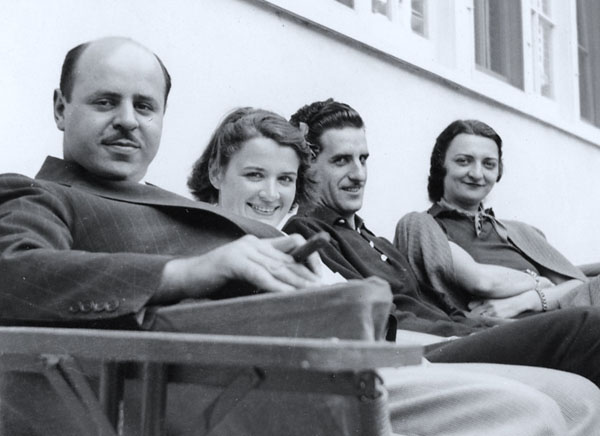
Throughout his career in animation, Art Davis saved many artifacts, such as group photographs that include him and various staff members, production artwork from various studios, gag drawings, contracts and correspondence. Many items shown here are courtesy of Steven Marshall, the user who submitted the photograph and husband of Art Davis’ granddaughter. This post is a gallery of some of these items. (Some of the drawings reproduced here are from low-res files and cut off the full image, so please excuse the quality.)
First, here’s a recent discovery. This might be the earliest known artwork by Art Davis (then fifteen years old). It was published in The Yonkers Herald on January 28, 1921. A corresponding photo of the high school students that submitted drawings to the Yonkers Chamber of Commerce was published February 10, where Davis can be seen in the lower far right.


While he was an animator at a studio run by Ben Harrison and Manny Gould in New York, Davis seemed to have contacted Walt Disney for a job, undoubtedly in response to the innovations and success of the early Mickey Mouse cartoons. Here is a response from Disney to Davis, dated July 10, 1929:

Documentation is scarce to support this piece of speculation, but the next telegram makes it seem Van Beuren disapproved of Dick Huemer, Sid Marcus and Davis making Toby the Pup cartoons directly for RKO. It appears he wanted to make the trio part of his studio and sell their services to RKO that way. This is dated April 2, 1931. Van Beuren’s human characters Tom and Jerry debuted in Wot a Night, released four months later in August.

Here is a higher-resolution photograph of the Charles Mintz staff, circa 1931. Since Ben Harrison, Manny Gould, Al Rose or Harry Love– who primarily worked on the Krazy Kat series— are not present in the picture, it’s possible that the two units at Mintz took separate group photos. This was taken at 5454 Virginia Avenue, around the corner from their studio on 1154 North Western Avenue.
Davis stands second from the far left; next to him is Dick Huemer. Charles Mintz stands in the back center, with Sid Marcus next to him. Musical composer Joe De Nat stands next to Marcus, with his face obscured. Harry McCracken identified Sid Glenar as the man kneeling on the far left. (If anyone can identify the other staffers in this photograph, please comment below.)
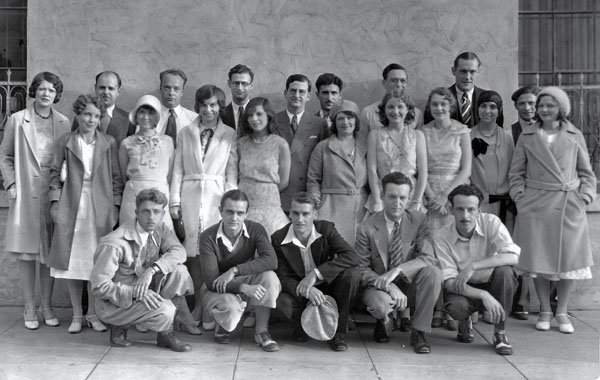
Here is a contract from April 12, 1932 which reveals Davis’ salary as an animator at Charles Mintz’s studio. (Adjusted for inflation, $225 in 1932 is equivalent to $4,319.57 today.)
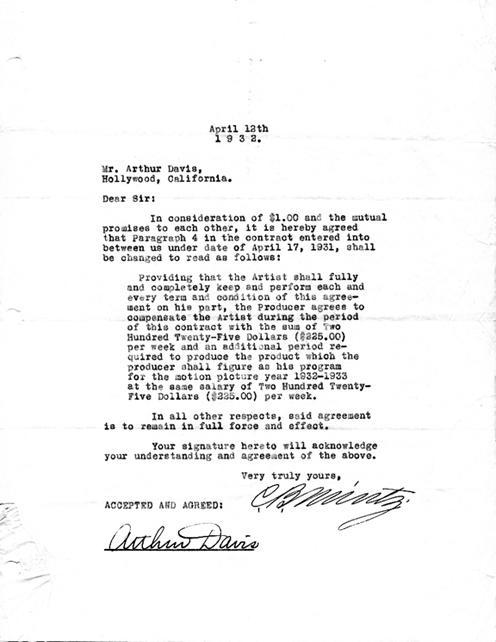
Here are some gag drawings of Davis from his time at Screen Gems – with caricatures of Sid Marcus included – that mostly poke fun at his baldness. These seem to originate sometime between the mid-thirties to the early forties.
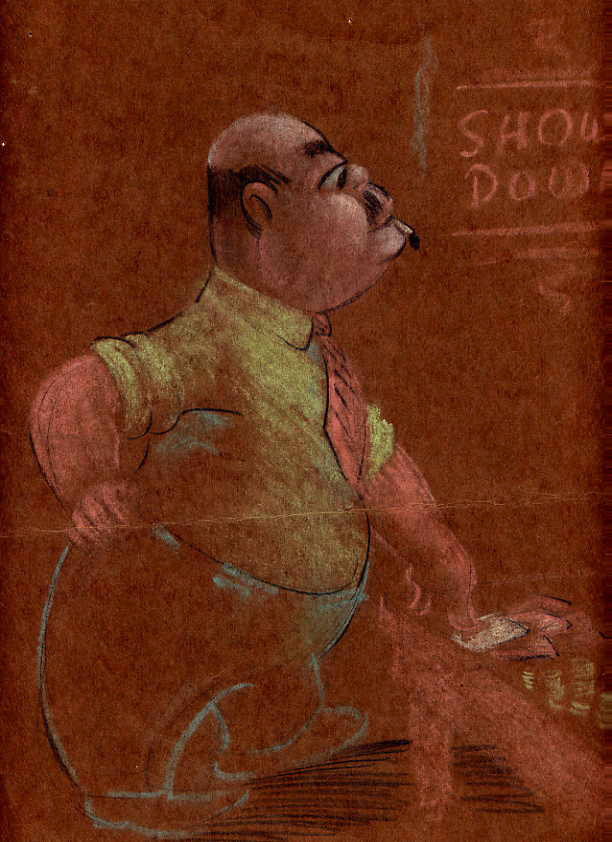
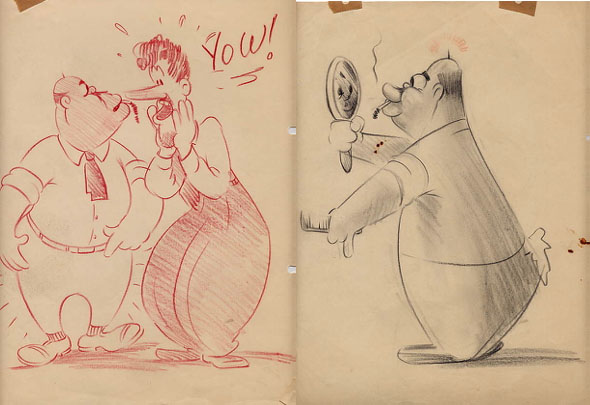
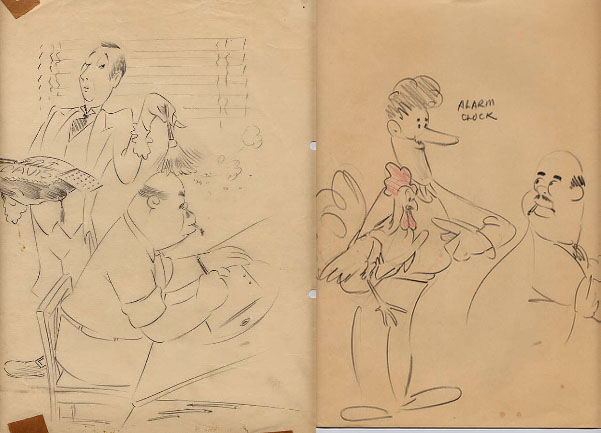
After Davis was terminated from Screen Gems in the early 1940s, he made another attempt to apply to Walt Disney’s studio. Walt Disney’s studio evolved significantly between 1929 and 1942, With the studio’s high volume of personnel and Disney’s struggles to keep afloat financially, Disney was no longer able to maintain relationships with a large number of staffers compared to the smaller crew he had fostered earlier. It does seem reasonable that Davis’ application would be rejected.
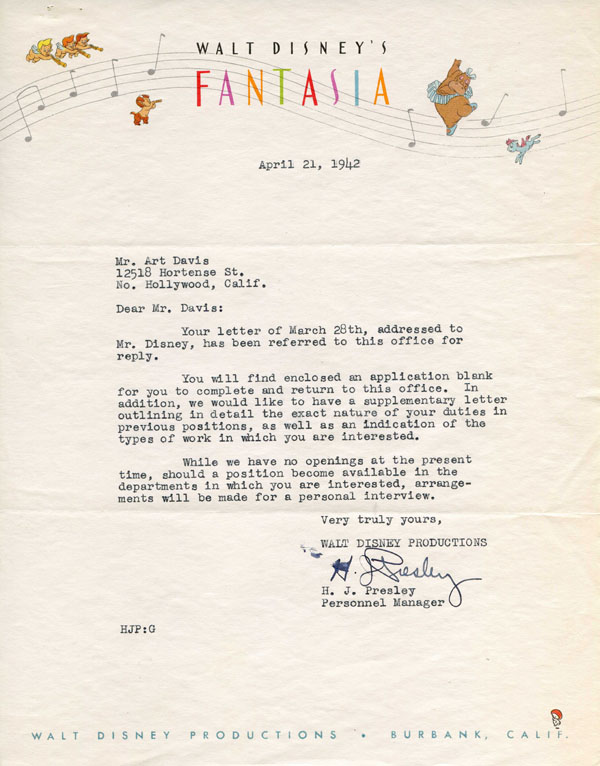
Davis’ application to Leon Schlesinger’s is not accessible as of this writing. However, the earliest known cartoons he animated for the studio (without credit), The Daffy Duckaroo (1942) and Confusions of a Nutzy Spy (1943) had dialogue sessions recorded between June and July 1942; Duckaroo was released October 24, 1942 and Nutzy Spy on January 23, 1943. Considering the faster production schedules for black-and-white cartoons from script to screen, Davis might have joined Schlesinger’s in either month.
Here are some model sheets and character sketches from Warners cartoons Davis directed: The Rattled Rooster (1947), Odor of the Day (1948), The Stupor Salesman (1948) and Porky Chops (1949).


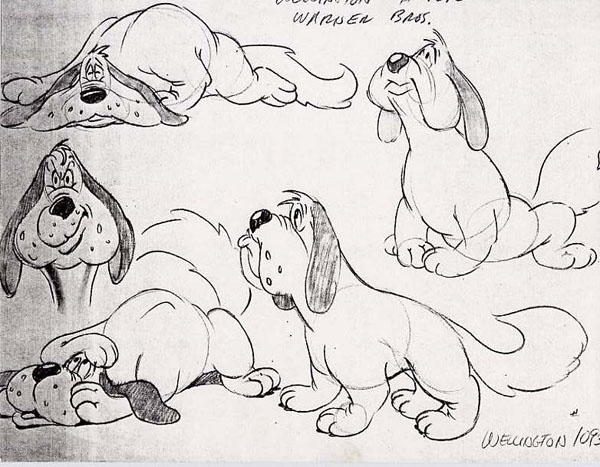
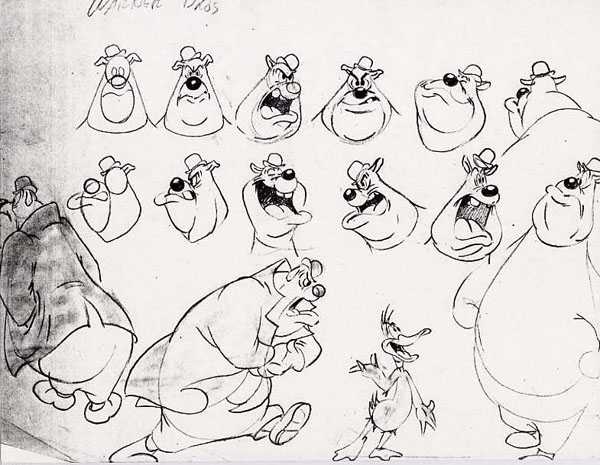
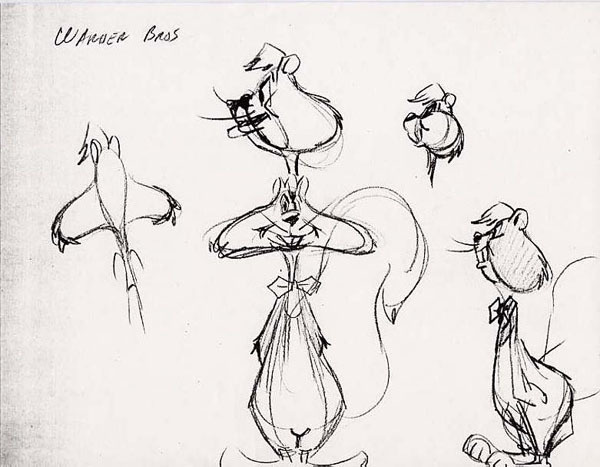
Davis is given a co-writer credit on the Oscar-nominated Sandy Claws (1955). Revealing the cartoon’s working title, this document was signed September 25, 1952, indicating the film was well into production before the studio shutdown in the summer of 1953. He revealed in an interview that co-writer Warren Foster only pitched the storyboard to Friz Freleng and that he did not have the authority to omit Foster’s name from the screen credits. (The $300 payment is equivalent to $3,023.25 in 2021 currency.)

Here is a 1952 letter from Izzy Sparber – a former colleague from Max Fleischer’s Inkwell studio in the 1920s – inquiring about a West Coast story man who would be willing to work at Famous Studios in Manhattan.

I’m sure many of you have seen this photograph before, but not in such great quality. This photo was taken at Warners circa 1954. Standing in the back row are Ray Young, Ted Bonnicksen. Gerry Chiniquy stands in the back row. Bob Matz, Warren Batchelder, Art Davis, John Brandt, and Sid Farren are seen at the front. If you look closely, you can see Davis is working on a scene from Freleng’s A Kiddie’s Kitty, released August 1955.

As I mentioned in Davis’ animator profile, the studio planned to activate a unit for television commercials with Davis in charge. However, the studio brought in Phil Monroe, a former animator at the studio who had experience in several commercial studios, to head the unit. Davis demanded a release from his contract, writing an indignant letter to Dave DePatie on June 17, 1960. Here is the letter and the release from Davis’ contract:


Here is a character sketch from Quackodile Tears (1962), directed by Davis in his spare time while he was working at Hanna-Barbera.

Jumping far ahead to the early 1980s, when Davis was hospitalized for heart bypass surgery. Here is a drawing of a nurse that cared for him during his recovery, with the Warners characters fawning over her.
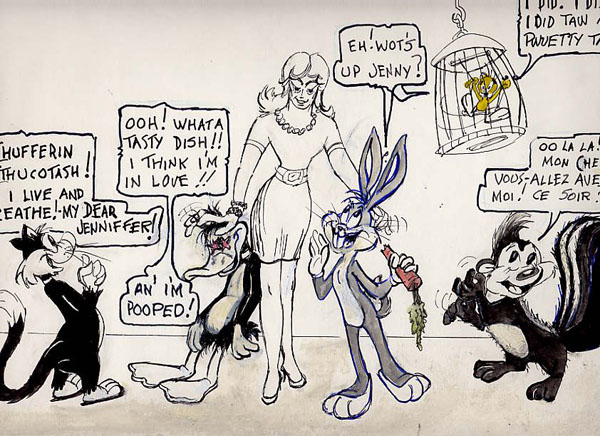
To conclude this gallery, here are a series of photographs taken during an impromptu visit for Hawley Pratt at the Motion Picture Home in Woodland Hills—a visit suggested by Art Leonardi.
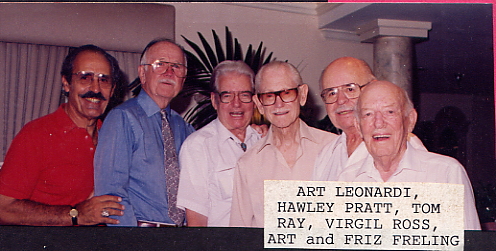
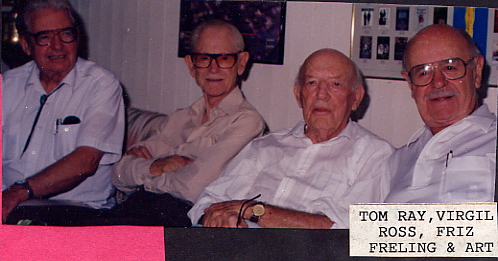
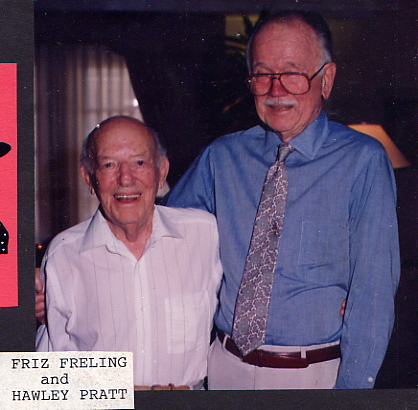
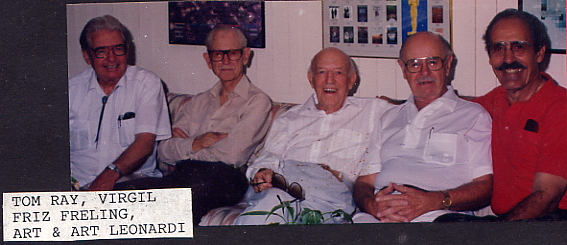


EDITOR’S NOTE: Please support Devon’s further research efforts by becoming one of his Patreon supporters. Here’s the link.


 DEVON BAXTER is a film restoration artist, video editor, and animation researcher/writer currently residing in Pennsylvania. He also hosts a
DEVON BAXTER is a film restoration artist, video editor, and animation researcher/writer currently residing in Pennsylvania. He also hosts a 





















































































Always a great article from you, Devon! Thanks so much!
Joe Musial, a classmate of Davis at Yonkers High School and a runner-up in the Chamber of Commerce cartoon contest that Davis won, later drew the Katzenjammer Kids comic strip for many years.
Some of those caricatures of Davis are reminiscent of Steve Brody in “Bowery Bugs”.
Thanks to you and Steven Marshall for sharing this information on one of the twentieth century’s great animators. I think Davis was at least the equal of Freleng, but for whatever reason didn’t have the same breaks. Too bad “Nurse Jenny” never got her own series.
Wonderful finds. I think these might be the only photos of Friz Freleng I’ve seen where he actually looks happy.
The drawing of Daffy on the Stupor Salesman model sheet kind of resembles how Davis would later draw him in his animation for Freleng’s fifties cartoons (Stork Naked, Show Biz Bugs, etc).
Looking at these pictures is like seeing the evolution of an artist. Compare that drawing he did as a teenager (a much appreciated find, BTW – thanks, Devon!) to those model sheets he did for Warner Bros. Really shows how his art changed with the times.
While he never got to become a household name like Chuck Jones or Tex Avery, I’m still glad we got his work, and that he managed to stick around to become an elder statesman of sorts (the same sadly couldn’t have been said of Frank Tashlin or Robert McKimson, both of whom passed in the 70s), sticking around until the dawn of the new millennium.
If there’s one thing I wish could have been altered about the Warner Bros. animation history, I would have Davis be allowed to direct cartoons for at least one more year.
Thank you for sharing these with us, Devon!!
Thank you for allowing these to be shared, Devon! And I’m proud to have brought the photo on the IAD Forums to Devon’s attention. 😉
Man, those gag drawings are sublime! Thanks for sharing all this material, Devon and Mr. Marshall!
Erm, the studio’s corporate name became Screen Gems, Inc. in 1931, judging from the films’ copyright notices/registrations (and a circa 1932–33 photo of the 7000 Santa Monica Blvd. studio with the name above the entrance). It just went by “The Charles Mintz Studio” as a sort of “doing business as” moniker until Mintz was out of the picture.
Where’s the “higher resolution”?
Yes, there were separate photos taken there covering the Harrison–Gould unit, as well as smaller group photos focusing on just the key people in each unit (directors and animators). The Scrappyland site has both a full and “smaller” photo for the Huemer–Marcus–Davis unit: https://www.scrappyland.com/blog/staff/. Leonard Maltin’s “Of Mice & Magic” includes a “smaller” photo of the Harrison–Gould unit, which was used in Joe Campana’s old blog post [link] matching the photos with the 5454 Virginia Ave. building. I seem to recall seeing a “full” photo of the Harrison–Gould crew somewhere, but can’t remember where off-hand.
There were multiple/alternate stills taken of at least some of the groups for some reason. The “full” photo in this post is different from the one on the Scrappyland page, and here’s another one of the Harrison–Gould crew that also omits George Winkler (originally shared on the Animation Guild blog in 2007): http://web.archive.org/web/20120604044400/http://www.animationguild.org/_ReuseLibrary/blogart/bobfpix/Mintz.jpg
Great article, thank you so much!!
Good post, Devon!
Ever since seeing Davis’ “Riff-Raff Daffy”, I’ve always considered it among the best of the WB cartoons. Thank you for this chance to know more about this guy!
I believe that Art Davis’ first job in Animation was when he was made the Assistant to Dick Huemer at Max Fleischer’s Inkwell Studios in 1923/24. In the process, Art by all practical conclusion was the first official Inbetweener in the business. This is a significant detail worth mentioning especially since the Inbetweeing process was an integral part of production at The Inkwell Studio. Other studios relied on their Animators to complete each scene themselves. The Inbetweeing method proved to be an efficient process that allowed Animators to produce more work and helped shorten production time with an increased release of films. While Otto Messmer is said to have been doing Inbetweening before this, the issue is that the process was not put into full use by the industry until the demand for sound cartoons created a need for more product.
But Art Davis is a largely unrecognized and under rated Director who deserves greater attention. Thank you for posting this, Devon.
Very nice. Thank you, Devon!
I’m creating a cartoon. It’s called, Forgotten Tales! It’s about these forgotten and obscure characters that go on wacky and crazy adventures.